A Novel Approach for Assessing the Performance of Sustainable Urbanization Based on Structural Equation Modeling: A China Case Study
Abstract
:1. Introduction
2. Literature Review
2.1. Constructs of Sustainable Urbanization
2.2. Evaluation of Sustainable Urbanization
3. A New Assessment Model Based on Structural Equation Modeling
3.1. Conceptual Framework of the Assessment Model
3.2. Model Solution
3.3. Assess the Performance of the Sustainable Urbanization
3.3.1. Normalization for All Indicators
3.3.2. Weights for All Indicators
3.3.3. Evaluation of Sustainable Urbanization Performance
4. Applications of the New Assessment Model
4.1. Data Collection and Preparation
4.2. Construct Validity
4.3. SEM Model Calculation and Refinement
4.4. Calculation Results and Analysis
5. Conclusions
Acknowledgments
Author Contributions
Conflicts of Interest
References
- Zhou, J.; Zhang, X.; Shen, L. Urbanization bubble: Four quadrants measurement model. Cities 2015, 46, 8–15. [Google Scholar] [CrossRef]
- Ann, T.W.; Wu, Y.; Zheng, B.; Zhang, X.; Shen, L. Identifying risk factors of urban-rural conflict in urbanization: A case of China. Habitat Int. 2014, 44, 177–185. [Google Scholar]
- Shen, L.Y.; Zhou, J. Examining the effectiveness of indicators for guiding sustainable urbanization in China. Habitat Int. 2014, 44, 111–120. [Google Scholar] [CrossRef]
- Zhao, J.; Chai, L. A novel approach for urbanization level evaluation based on information entropy principle: A case of Beijing. Phys. A Stat. Mech. Appl. 2015, 430, 114–125. [Google Scholar] [CrossRef]
- Ministry of Construction of China. Statistical Communiqué on Urban Construction 2003; Ministry of Construction of China: Beijing, China, 2003. (In Chinese)
- Zhang, C.; Lin, Y. Panel estimation for urbanization, energy consumption and CO2 emissions: A regional analysis in China. Energy Policy 2012, 49, 488–498. [Google Scholar] [CrossRef]
- The World Bank. Urban China: Toward Efficient, Inclusive, and Sustainable Urbanization. Available online: http://www.worldbank.org/content/dam/Worldbank/document/EAP/China/urban-china-overview-cn.pdf (accessed on 28 March 2014).
- Zhang, X.; Wu, Y.; Skitmore, M.; Jiang, S. Sustainable infrastructure projects in balancing urban-rural development: Towards the goal of efficiency and equity. J. Clean. Prod. 2014, 107, 445–454. [Google Scholar] [CrossRef]
- Ma, L.; Liu, P.; Fu, F.; Li, Z.; Ni, W. Integrated energy strategy for the sustainable development of China. Energy 2011, 36, 1143–1154. [Google Scholar] [CrossRef]
- Zhang, X. Sustainable urbanization: A BI-dimensional matrix model. J. Clean. Prod. 2016, 134, 425–433. [Google Scholar] [CrossRef]
- Michael, F.L.; Noor, Z.Z.; Figueroa, M.J. Review of urban sustainability indicators assessment—Case study between Asian countries. Habitat Int. 2014, 44, 491–500. [Google Scholar] [CrossRef]
- Tan, Y.; Xu, H.; Zhang, X. Sustainable urbanization in China: A comprehensive literature review. Cities 2016, 55, 82–93. [Google Scholar] [CrossRef]
- Han, J.; Hayashi, Y.; Cao, X.; Imura, H. Application of an integrated system dynamics and cellular automata model for urban growth assessment: A case study of Shanghai, China. Landsc. Urban Plan. 2009, 91, 133–141. [Google Scholar] [CrossRef]
- Uwasu, M.; Yabar, H. Assessment of sustainable development based on the capital approach. Ecol. Indic. 2011, 11, 348–352. [Google Scholar] [CrossRef]
- Zhou, D.; Xu, J.; Wang, L.; Lin, Z. Assessing urbanization quality using structure and function analyses: A case study of the urban agglomeration around Hangzhou Bay (UAHB), China. Habitat Int. 2015, 49, 165–176. [Google Scholar] [CrossRef]
- Grigoroudis, E.; Kouikoglou, V.S.; Phillis, Y.A. SAFE 2013: Sustainability of countries updated. Ecol. Indic. 2014, 38, 61–66. [Google Scholar] [CrossRef]
- Phillis, Y.A.; Grigoroudis, E.; Kouikoglou, V.S. Sustainability ranking and improvement of countries. Ecol. Econ. 2011, 70, 542–553. [Google Scholar] [CrossRef]
- Zijp, M.C.; Heijungs, R.; van der Voet, E.; van de Meent, D.; Huijbregts, M.A.J.; Hollander, A.; Posthuma, L. An identification key for selecting methods for sustainability assessments. Sustainability 2015, 7, 2490–2512. [Google Scholar] [CrossRef]
- Huang, S.L.; Chen, C.W. A System Dynamics Approach to the Simulation of Urban Sustainability; Ecosystems and Sustainable Development II, WIT Press: Southampton, UK, 1999. [Google Scholar]
- Huang, L.; Yan, L.; Wu, J. Assessing urban sustainability of Chinese megacities: 35 years after the economic reform and open-door policy. Landsc. Urban Plan. 2016, 145, 57–70. [Google Scholar] [CrossRef]
- Huang, S.L.; Yeh, C.T.; Budd, W.W.; Chen, L.L. A Sensitivity Model (SM) approach to analyze urban development in Taiwan based on sustainability indicators. Environ. Impact Assess. Rev. 2009, 29, 116–125. [Google Scholar] [CrossRef]
- WCED, U. Our Common Future; World Commission on Environment and Development Oxford University Press: Oxford, UK, 1987. [Google Scholar]
- Roy, M. Planning for sustainable urbanization in fast growing cities: Mitigation and adaptation issues addressed in Dhaka, Bangladesh. Habitat Int. 2009, 33, 276–286. [Google Scholar] [CrossRef]
- Shen, L.; Peng, Y.; Zhang, X.; Wu, Y. An alternative model for evaluating sustainable urbanization. Cities 2012, 29, 32–39. [Google Scholar] [CrossRef]
- Marcotullio, P.J. Asian urban sustainability in the era of globalization. Habitat Int. 2001, 25, 577–598. [Google Scholar] [CrossRef]
- Harris, N. Wastes, the environment and the international economy. Cities 1992, 9, 177–185. [Google Scholar] [CrossRef]
- Shen, L.; Shuai, C.; Jiao, L.; Tan, Y.; Song, X. A Global Perspective on the Sustainable Performance of Urbanization. Sustainability 2016, 8, 783. [Google Scholar] [CrossRef]
- Dye, C. Health and urban living. Science 2008, 319, 766–769. [Google Scholar] [CrossRef] [PubMed]
- Zhou, J.; Shen, L.; Song, X.; Zhang, X. Selection and modeling sustainable urbanization indicators: A responsibility-based method. Ecol. Indic. 2015, 56, 87–95. [Google Scholar] [CrossRef]
- Jaeger, J.A.G.; Bertiller, R.; Schwick, C.; Kienast, F. Suitability criteria for measures of urban sprawl. Ecol. Indic. 2010, 10, 397–406. [Google Scholar] [CrossRef]
- El Araby, M. Urban growth and environmental degradation: The case of Cairo, Egypt. Cities 2002, 19, 389–400. [Google Scholar] [CrossRef]
- Dizdaroglu, D.; Yigitcanlar, T.; Dawes, L.A. Sustainable Urban Futures: An Ecological Approach to Sustainable Urban Development. In Proceedings of the Second Infrastructure Theme Postgraduate Conference 2009: Rethinking Sustainable Development-Planning, Infrastructure Engineering, Design and Managing Urban Infrastructure, Brisbane, Australia, 9 July 2010; pp. 187–195.
- Yigitcanlar, T.; Dizdaroglu, D. Assessing Urban Ecosystem Sustainability: An Indexing Approach. Available online: http://s3.amazonaws.com/academia.edu.documents/30968394/Assessing-urban-ecosystem-sustainability-an-indexing approach. pdf?AWSAccessKeyId=AKIAJ56TQJRTWSMTNPEA& Expires=1468819753&Signature=dqbGGXjzNGsfUhgrzvlV3FYqR7w%3D&response-content-disposition=inline%3B%20filename%3DAssessing_urban_ecosystem_sustainability.pdf (accessed on 23 May 2014).
- Zhang, N.; Lior, N.; Jin, H. The energy situation and its sustainable development strategy in China. Energy 2011, 36, 3639–3649. [Google Scholar] [CrossRef]
- Gustavson, K.R.; Lonergan, S.C.; Ruitenbeek, H.J. Selection and modeling of sustainable development indicators: A case study of the Fraser River Basin, British Columbia. Ecol. Econ. 1999, 28, 117–132. [Google Scholar] [CrossRef]
- Hezri, A.A.; Hasan, M.N. Management framework for sustainable development indicators in the State of Selangor, Malaysia. Ecol. Indic. 2004, 4, 287–304. [Google Scholar] [CrossRef]
- Yigitcanlar, T.; Dur, F. Developing a sustainability assessment model: The sustainable infrastructure, land-use, environment and transport model. Sustainability 2010, 2, 321–340. [Google Scholar] [CrossRef]
- Shen, L.Y.; Ochoa, J.J.; Shah, M.N.; Zhang, X. The application of urban sustainability indicators—A comparison between various practices. Habitat Int. 2011, 35, 17–29. [Google Scholar] [CrossRef]
- Quyên, Đ.T.N. Developing University Governance Indicators and Their Weighting System Using a Modified Delphi Method. Proced. Soc. Behav. Sci. 2014, 141, 828–833. [Google Scholar] [CrossRef]
- Hsueh, S.L. Assessing the effectiveness of community-promoted environmental protection policy by using a Delphi-fuzzy method: A case study on solar power and plain afforestation in Taiwan. Renew. Sustain. Energy Rev. 2015, 49, 1286–1295. [Google Scholar] [CrossRef]
- Guerrero-Liquet, G.C.; Sánchez-Lozano, J.M.; García-Cascales, M.S.; Lamata, M.T.; Verdegay, J.L. Decision-Making for Risk Management in Sustainable Renewable Energy Facilities: A Case Study in the Dominican Republic. Sustainability 2016, 8, 455. [Google Scholar] [CrossRef]
- Shemshadi, A.; Shirazi, H.; Toreihi, M.; Tarokh, M.J. A fuzzy VIKOR method for supplier selection based on entropy measure for objective weighting. Expert Syst. Appl. 2011, 38, 12160–12167. [Google Scholar] [CrossRef]
- Shen, L.; Zhou, J.; Skitmore, M.; Xia, B. Application of a hybrid Entropy–McKinsey Matrix method in evaluating sustainable urbanization: A China case study. Cities 2015, 42, 186–194. [Google Scholar] [CrossRef]
- Liang, X.; Zhang, W.; Chen, L.; Deng, F. Sustainable urban development capacity measure—A case study in Jiangsu Province, China. Sustainability 2016, 8, 270. [Google Scholar] [CrossRef]
- Guo, Y.B.; Wei, H.K. A Review of Literature on Urbanization Quality Evaluation. J. Grad. Sch. Chin. Acad. Soc. Sci. 2013, 2, 37–43. (In Chinese) [Google Scholar]
- Fang, D.; Wu, C.; Wu, H. Impact of the supervisor on worker safety behavior in construction projects. J. Manag. Eng. 2015, 31, 04015001. [Google Scholar] [CrossRef]
- Xiong, B.; Skitmore, M.; Xia, B. A critical review of structural equation modeling applications in construction research. Autom. Constr. 2015, 49, 59–70. [Google Scholar] [CrossRef]
- Shen, W.; Xiao, W.; Wang, X. Passenger satisfaction evaluation model for urban rail transit: A structural equation modeling based on partial least squares. Transp. Policy 2016, 46, 20–31. [Google Scholar] [CrossRef]
- Evermann, J.; Tate, M. Assessing the predictive performance of structural equation model estimators. J. Bus. Res. 2016, 69, 4565–4582. [Google Scholar] [CrossRef]
- Liu, G.; You, T. The evaluation the development level of integrated urban Eco-system. Urban Dev. Stud. 2013, 20, 108–112. (In Chinese) [Google Scholar]
- Guan, W.F.; Zhang, K.; Yang, X. Urban competitiveness evaluation based on the structural equation model. Econ. Manag. 2013, 24, 41–45. (In Chinese) [Google Scholar]
- Mo, Y.K.; Deng, J.; Yan, K.F. Public evaluation of urban transit system based on structural equation modeling. J. Hefei Univ. Technol. 2010, 33, 704–708. (In Chinese) [Google Scholar]
- Yu, S.H.; Yang, W. The evaluation model of regional tourism industry competition via structural equation. J. Dalian Univ. Technol. 2011, 32, 44–47. (In Chinese) [Google Scholar]
- USI 2013 Index System Framework. Available online: http://www.urbanchinainitiative.org/en/resources/dev_page.html (accessed on 31 August 2016).
- National Bureau of Statistics of China. National Data. Available online: http://data.stats.gov.cn (accessed on 15 March 2016).
- Doloi, H.; Iyer, K.C.; Sawhney, A. Structural equation model for assessing impacts of contractor’s performance on project success. Int. J. Proj. Manag. 2011, 29, 687–695. [Google Scholar] [CrossRef]
- Discriminant Validity. Available online: https://en.wikipedia.org/wiki/Discriminant_validity#cite_note-henseler 2014-3 (accessed on 30 August 2016).
- Isik, Z.; Arditi, D.; Dikmen, I.; Birgonul, M.T. Impact of corporate strengths/weaknesses on project management competencies. Int. J. Proj. Manag. 2009, 27, 629–637. [Google Scholar] [CrossRef]
- Meng, J.; Xue, B.; Liu, B.; Fang, N. Relationships between top managers’ leadership and infrastructure sustainability: A Chinese urbanization perspective. Eng. Constr. Archit. Manag. 2015, 22, 692–714. [Google Scholar] [CrossRef]
- Jackson, D.L.; Gillaspy, J.A., Jr.; Purc-Stephenson, R. Reporting practices in confirmatory factor analysis: An overview and some recommendations. Psychol. Methods 2009, 14, 6–23. [Google Scholar] [CrossRef] [PubMed]
- Deng, X.Z.; Zhong, H.Y.; Bai, X.M. Path of Sustainable Urbanization in Western China. China Popul. Resour. Environ. 2013, 23, 24–30. (In Chinese) [Google Scholar]
- Xie, S.H.; Cai, H.Y.; Lou, T.T. Evaluation on the urbanization quality of province in China. Urban Probl. 2015, 8, 16–21. (In Chinese) [Google Scholar]
- He, P.; Ni, P. Study on the quality of China’s Urbanization. Stat. Res. 2013, 6, 11–18. (In Chinese) [Google Scholar]
- Zhang, Z.B.; Huang, K. The measurement and evaluation of the health status of China’s new urbanization. Comp. Econ. Soc. Syst. 2014, 4, 32–42. (In Chinese) [Google Scholar]
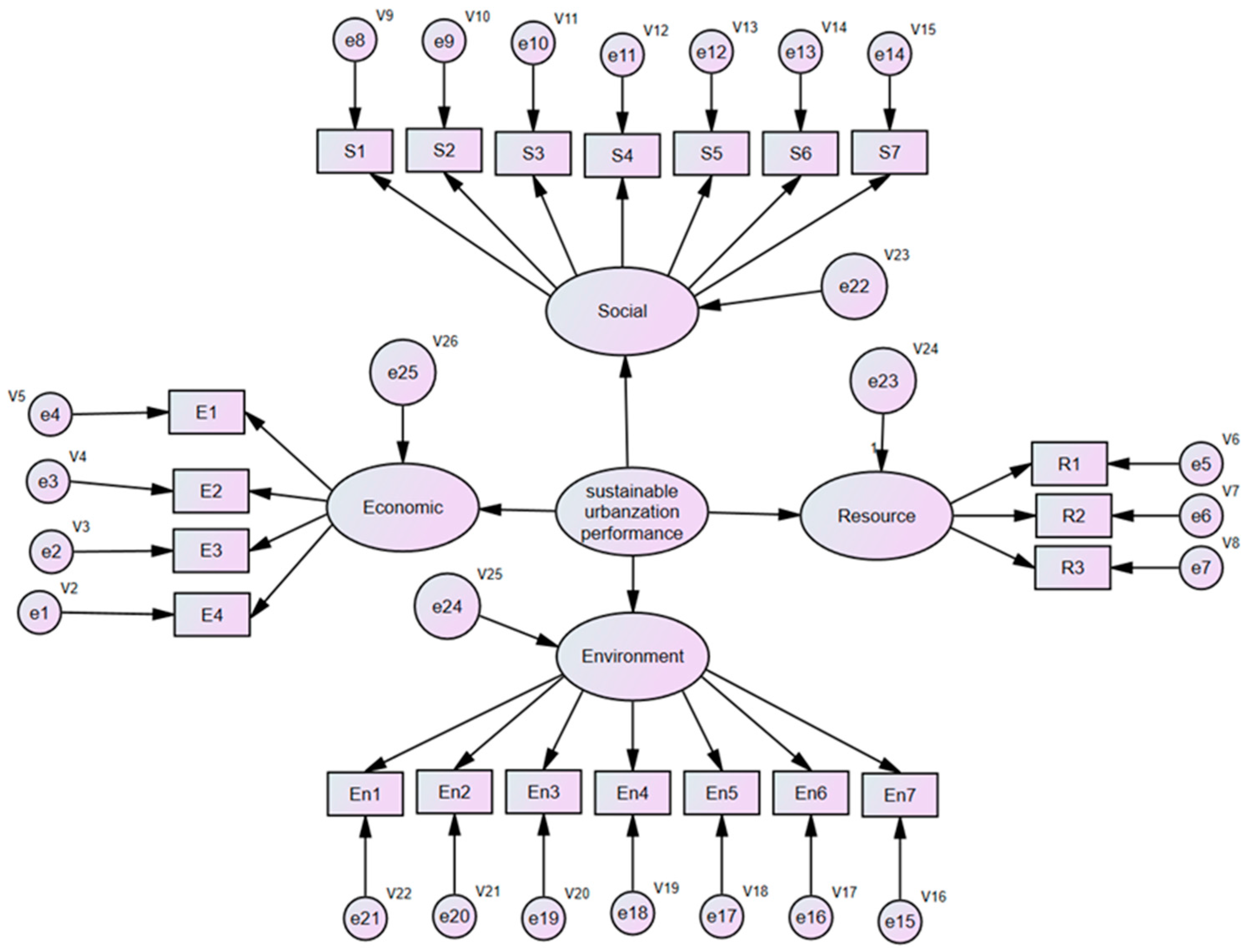
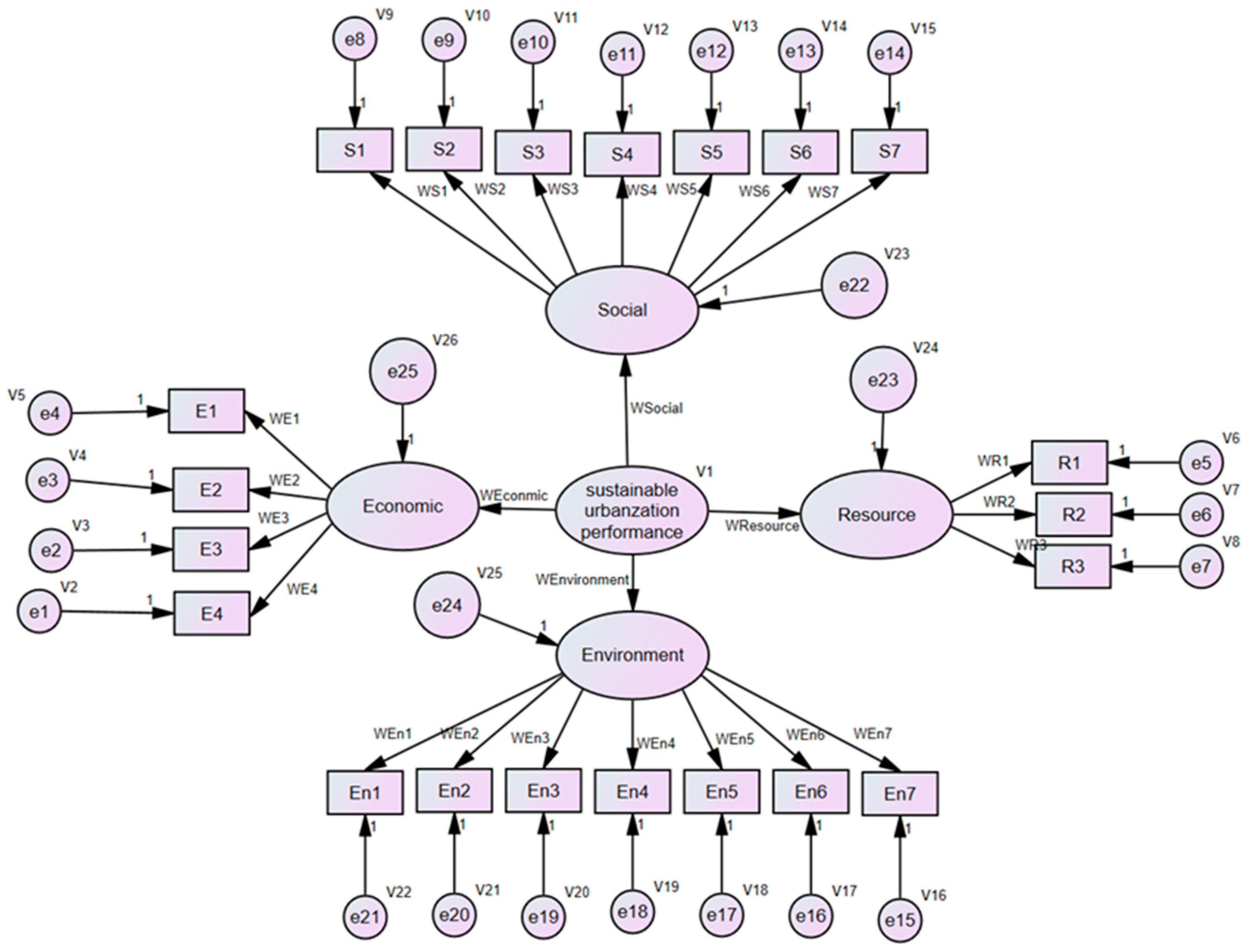

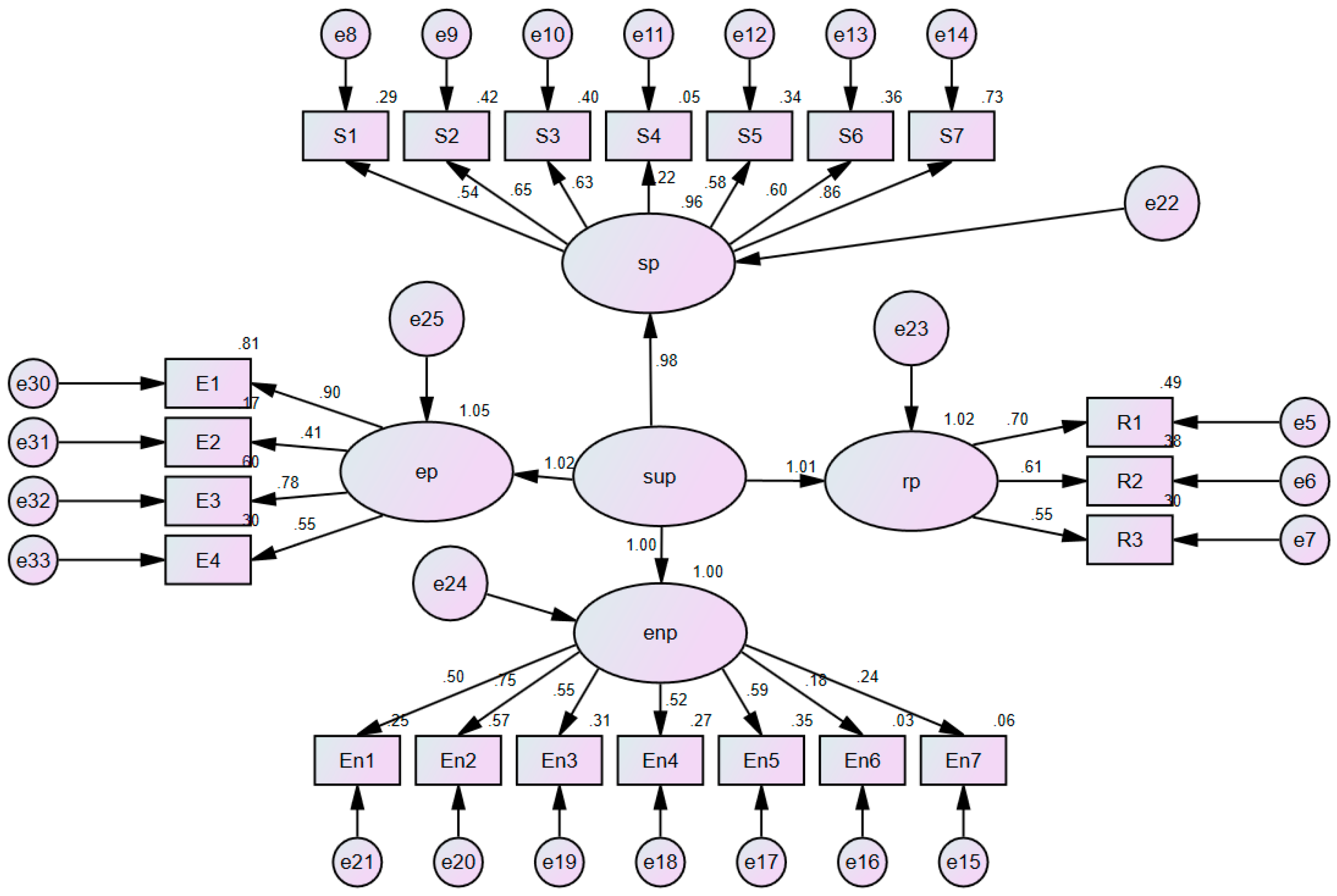
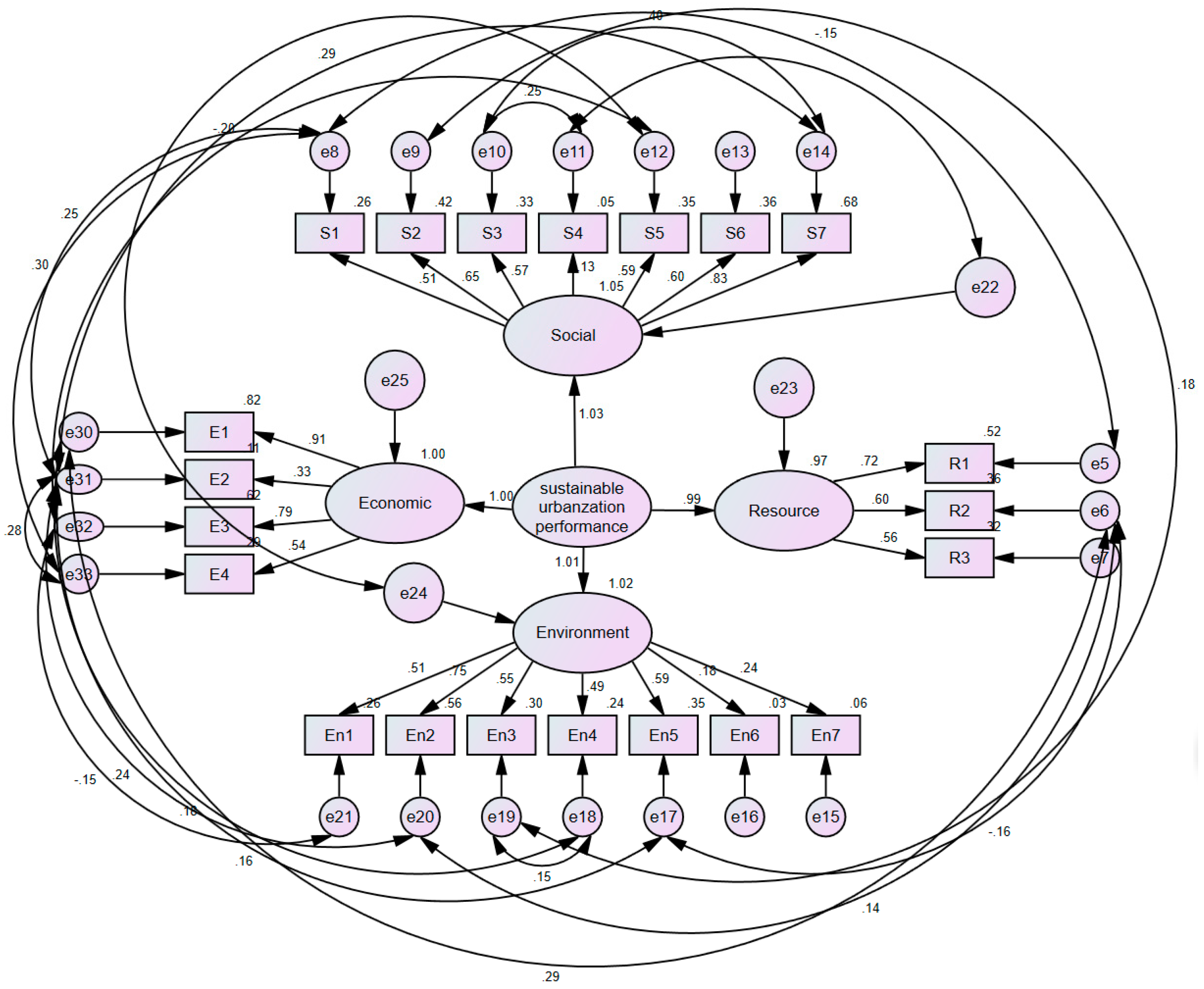
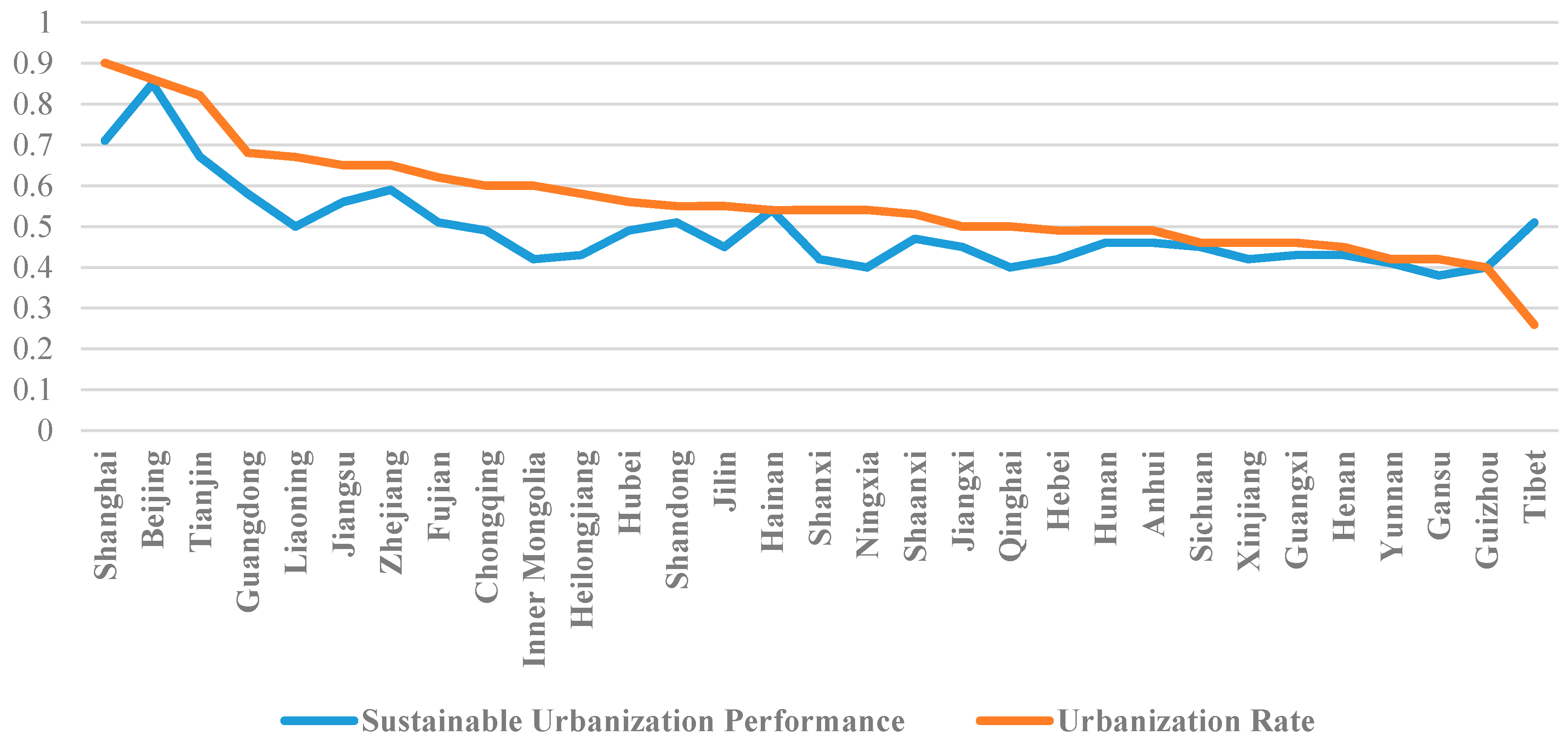
| Dimensions | Indicators | Codes |
|---|---|---|
| Economic | Per capita GDP | E1 |
| GDP from service industry (%) | E2 | |
| Disposable income per urban capita | E3 | |
| Government investment in R&D per capita | E4 | |
| Social | Urban unemployment rate (%) | S1 |
| Number of doctors per capita (per ten thousand urban population) | S2 | |
| Pension security coverage (%) | S3 | |
| Number of middle school students (per ten thousand urban population) | S4 | |
| Number of books per person in public libraries | S5 | |
| Urban road area per capita | S6 | |
| Household access to Internet in total urban household (%) | S7 | |
| Environment | Wastewater treatment rate (%) | En1 |
| Industrial SO2 discharged per unit GDP (tons per bn RMB) | En2 | |
| Domestic waste treated rate (%) | En3 | |
| Coverage of public green space in built area (%) | En4 | |
| Passengers using public transit (per capita) | En5 | |
| Public water supply coverage (%) | En6 | |
| Persons per square kilometer of urban area | En7 | |
| Resource | Water efficiency | R1 |
| Residential power consumption (kwh per capita) | R2 | |
| Total energy consumption per unit GDP | R3 |
| Dimensions | Value of R |
|---|---|
| economic and social | 0.88 |
| economic and environment | 0.78 |
| economic and resource | 0.88 |
| social and environment | 0.81 |
| social and resource | 0.89 |
| environment and resource | 0.85 |
| GOF Measures | Initial SEM | Recommended Levels | Resources |
|---|---|---|---|
| χ2/degrees of freedom | 2.31 | 1–2 | [56,58,59,60] |
| Goodness-of-fit index (GFI) | 0.845 | >0.9 | [56,58,59,60] |
| Adjusted goodness-of-fit index (AGFI) | 0.807 | >0.9 | [56,58,59,60] |
| Root mean square error of approximation (RMSEA) | 0.073 | <0.05 | [56,58,59,60] |
| Index Name | GOF Measures | Refined SEM | Recommended Levels | Evaluation |
|---|---|---|---|---|
| Absolute fit index | χ2/df | 1.1 | 1–2 | Acceptable |
| RMSEA | 0.02 | <0.05 | Acceptable | |
| RMR | 0.033 | <0.05 | Acceptable | |
| GFI | 0.935 | >0.9 | Acceptable | |
| AGFI | 0.909 | >0.9 | Acceptable | |
| Incremental fit index | CFI | 0.992 | >0.9 | Acceptable |
| TLI | 0.99 | >0.9 | Acceptable | |
| NFI | 0.922 | >0.7 | Acceptable | |
| IFI | 0.992 | >0.9 | Acceptable | |
| TLI | 0.99 | >0.9 | Acceptable | |
| Parsimonious fit measure | PNFI | 0.729 | >0.5 | Acceptable |
| PGFI | 0.672 | >0.5 | Acceptable | |
| PCFI | 0.784 | >0.5 | Acceptable |
| Estimate | S.E. | C.R. | p | |||
|---|---|---|---|---|---|---|
| sp | <--- | sup | 1.027 | |||
| rp | <--- | sup | 0.986 | 0.285 | 7.421 | *** |
| enp | <--- | sup | 1.012 | 0.17 | 3.504 | *** |
| ep | <--- | sup | 1.002 | 0.146 | 8.027 | *** |
| E4 | <--- | ep | 0.543 | |||
| E3 | <--- | ep | 0.788 | 0.178 | 8.796 | *** |
| E2 | <--- | ep | 0.335 | 0.108 | 5.394 | *** |
| E1 | <--- | ep | 0.906 | 0.228 | 9.438 | *** |
| R1 | <--- | rp | 0.719 | |||
| R2 | <--- | rp | 0.598 | 0.089 | 8.97 | *** |
| R3 | <--- | rp | 0.562 | 0.081 | 8.588 | *** |
| S1 | <--- | sp | 0.505 | |||
| S2 | <--- | sp | 0.647 | 0.241 | 7.469 | *** |
| S3 | <--- | sp | 0.574 | 0.21 | 6.981 | *** |
| S4 | <--- | sp | 0.133 | 0.108 | 2.064 | *** |
| S5 | <--- | sp | 0.589 | 0.236 | 7.012 | *** |
| S6 | <--- | sp | 0.599 | 0.229 | 7.128 | *** |
| S7 | <--- | sp | 0.827 | 0.299 | 8.45 | *** |
| En7 | <--- | enp | 0.241 | |||
| En6 | <--- | enp | 0.181 | 0.349 | 2.271 | *** |
| En5 | <--- | enp | 0.589 | 0.795 | 3.607 | *** |
| En4 | <--- | enp | 0.492 | 0.671 | 3.495 | *** |
| En3 | <--- | enp | 0.548 | 0.906 | 3.569 | *** |
| En2 | <--- | enp | 0.747 | 1.107 | 3.723 | *** |
| En1 | <--- | enp | 0.514 | 0.908 | 3.528 | *** |
| Dimension Weights | Indicators | Indicators Weights |
|---|---|---|
| Economic (0.25) | Per capita GDP | 0.35 |
| GDP from service industry (%) | 0.13 | |
| Disposable income per urban capita | 0.31 | |
| Government investment in R&D per capita | 0.21 | |
| Social (0.26) | Urban unemployment rate (%) | 0.13 |
| Number of doctors per capita (per ten thousand urban population) | 0.17 | |
| Pension security coverage (%) | 0.15 | |
| Number of middle school students (per ten thousand urban population) | 0.03 | |
| Number of books per person in public libraries | 0.15 | |
| Urban road area per capita | 0.15 | |
| Household access to Internet in total urban household (%) | 0.21 | |
| Environment (0.25) | Wastewater treatment rate (%) | 0.16 |
| Industrial SO2 discharged per unit GDP (tons per bn RMB) | 0.23 | |
| Domestic waste treated rate (%) | 0.17 | |
| Coverage of public green space in built area (%) | 0.15 | |
| Passengers using public transit (per capita) | 0.18 | |
| Public water supply coverage (%) | 0.05 | |
| Persons per square kilometer of urban area | 0.07 | |
| Resource (0.24) | Water efficiency | 0.38 |
| Residential power consumption (kwh per capita) | 0.32 | |
| Total energy consumption per unit GDP | 0.3 |
| Provinces | Sup | Rank | Provinces | Sup | Rank |
|---|---|---|---|---|---|
| Beijing | 0.85 | 1 | Guangxi | 0.43 | 20 |
| Tianjin | 0.67 | 3 | Hainan | 0.54 | 7 |
| Hebei | 0.42 | 23 | Chongqing | 0.49 | 12 |
| Shanxi | 0.42 | 23 | Sichuan | 0.45 | 17 |
| Inner Mongolia | 0.42 | 23 | Guizhou | 0.40 | 28 |
| Liaoning | 0.50 | 11 | Yunnan | 0.41 | 27 |
| Jilin | 0.45 | 17 | Tibet | 0.51 | 8 |
| Heilongjiang | 0.43 | 20 | Shaanxi | 0.47 | 14 |
| Shanghai | 0.71 | 2 | Gansu | 0.38 | 31 |
| Guangdong | 0.58 | 5 | Qinghai | 0.40 | 28 |
| Xinjiang | 0.42 | 23 | Jiangxi | 0.45 | 17 |
| Jiangsu | 0.56 | 6 | Shandong | 0.51 | 8 |
| Zhejiang | 0.59 | 4 | Henan | 0.43 | 20 |
| Anhui | 0.46 | 15 | Hubei | 0.49 | 12 |
| Fujian | 0.51 | 8 | Hunan | 0.46 | 15 |
| Ningxia | 0.40 | 28 |
| Provinces | Sustainable Urbanization Performance | Urbanization Rate | Provinces | Sustainable Urbanization Performance | Urbanization Rate |
|---|---|---|---|---|---|
| Shanghai | 0.71 | 0.90 | Ningxia | 0.40 | 0.54 |
| Beijing | 0.85 | 0.86 | Shaanxi | 0.47 | 0.53 |
| Tianjin | 0.67 | 0.82 | Jiangxi | 0.45 | 0.50 |
| Guangdong | 0.58 | 0.68 | Qinghai | 0.40 | 0.50 |
| Liaoning | 0.50 | 0.67 | Hebei | 0.42 | 0.49 |
| Jiangsu | 0.56 | 0.65 | Hunan | 0.46 | 0.49 |
| Zhejiang | 0.59 | 0.65 | Anhui | 0.46 | 0.49 |
| Fujian | 0.51 | 0.62 | Sichuan | 0.45 | 0.46 |
| Chongqing | 0.49 | 0.60 | Xinjiang | 0.42 | 0.46 |
| Inner Mongolia | 0.42 | 0.60 | Guangxi | 0.43 | 0.46 |
| Heilongjiang | 0.43 | 0.58 | Henan | 0.43 | 0.45 |
| Hubei | 0.49 | 0.56 | Yunnan | 0.41 | 0.42 |
| Shandong | 0.51 | 0.55 | Gansu | 0.38 | 0.42 |
| Jilin | 0.45 | 0.55 | Guizhou | 0.40 | 0.40 |
| Hainan | 0.54 | 0.54 | Tibet | 0.51 | 0.26 |
| Shanxi | 0.42 | 0.54 |
© 2016 by the authors; licensee MDPI, Basel, Switzerland. This article is an open access article distributed under the terms and conditions of the Creative Commons Attribution (CC-BY) license (http://creativecommons.org/licenses/by/4.0/).
Share and Cite
Jiao, L.; Shen, L.; Shuai, C.; He, B. A Novel Approach for Assessing the Performance of Sustainable Urbanization Based on Structural Equation Modeling: A China Case Study. Sustainability 2016, 8, 910. https://doi.org/10.3390/su8090910
Jiao L, Shen L, Shuai C, He B. A Novel Approach for Assessing the Performance of Sustainable Urbanization Based on Structural Equation Modeling: A China Case Study. Sustainability. 2016; 8(9):910. https://doi.org/10.3390/su8090910
Chicago/Turabian StyleJiao, Liudan, Liyin Shen, Chenyang Shuai, and Bei He. 2016. "A Novel Approach for Assessing the Performance of Sustainable Urbanization Based on Structural Equation Modeling: A China Case Study" Sustainability 8, no. 9: 910. https://doi.org/10.3390/su8090910
APA StyleJiao, L., Shen, L., Shuai, C., & He, B. (2016). A Novel Approach for Assessing the Performance of Sustainable Urbanization Based on Structural Equation Modeling: A China Case Study. Sustainability, 8(9), 910. https://doi.org/10.3390/su8090910





